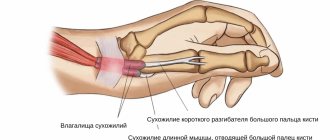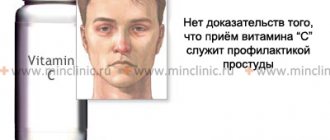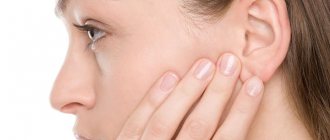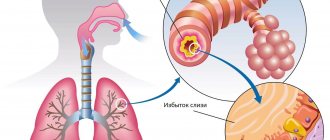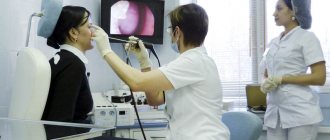Causes
In children, the disease develops after:
- adenoids;
- rubella;
- scarlet fever.
The causative agents of laryngotracheitis are microbes and viruses that cause acute respiratory viral infection. If timely treatment is provided, there will be no complications.
Basically, laryngotracheitis is a complication of viral infections:
- adenovirus;
- influenza virus;
- parainfluenza;
- measles;
- chicken pox and others.
Laryngotracheitis has bacterial causes and conditions of occurrence, and is a consequence of infection, for example, streptococcus, staphylococcus. With weak immunity, bacteria will join the viruses, which will lead to the occurrence of this disease and other troubles.
Treatment of laryngotracheitis
If symptoms of laryngotracheitis appear, you should contact your pediatrician.
The specialist will conduct an objective examination, if necessary, refer you to specialists (ENT, pulmonologist), and prescribe tests included in the examination standard. For viral etiologies of the disease, immunomodulators are prescribed to strengthen the immune system and speed up recovery. If the pathogen is identified and antiviral drugs have been developed against it, etiotropic treatment is prescribed. If the inflammation is bacterial in nature, penicillin antibiotics, macrolides or cephalosporins are recommended. The predominant route of administration is oral (prescribed tablets, suspensions).
For the complex treatment of acute laryngotracheitis in children, symptomatic drugs are indicated:
- mucolytics in the form of syrups or inhalations;
- antipyretics;
- distractions with local anesthetics to relieve sore throat - lozenges, spray.
For complete recovery after acute inflammation subsides, physiotherapy (electrophoresis), massage, and exercise therapy are indicated. Methods of physical influence help to mobilize the body's protective reserves and strengthen local immunity.
Symptoms
Signs appear after a person feels that he is unwell. The patient has:
- the temperature rises sharply;
- tickle in the throat;
- a little viscous and thick sputum is released;
- the voice becomes hoarse and hoarse.
There is discomfort in the larynx, burning and drying. A painful, dry, barking cough begins to torment. It becomes this way because there is swelling and spasms of the vocal cords. When coughing, the pain behind the sternum begins to worsen. Its attacks appear when a person inhales frosty or dusty air, breathes deeply or laughs.
When the disease enters the chronic stage, the symptoms become less pronounced and periods of decline are observed. A patient with chronic laryngotracheitis has a headache, a sore throat, and a change in voice. He doesn't want to do anything; he feels a lump in his throat. Before you say anything you have to clear your throat.
Complications
Laryngotracheitis may well lead to the development of complications; one of the most common and widespread is tracheobronchitis. It develops if treatment was untimely or was not completed.
Against the background of a chronic or too long illness, pneumonia can occur. The patient is subject to hospitalization due to increased intoxication. There is a risk of respiratory failure.
With frequent exacerbations of the chronic form or a protracted disease, tissue begins to grow. This can lead to the formation of benign tumors of the mucous membrane.
Asphyxia is considered a serious complication when the body does not receive oxygen. If it continues for a long time, fainting will occur and death will occur.
The disease can be aggravated by the appearance of narrowing of the lumen of the larynx. Presenters, artists and teachers whose profession involves speech and voice may experience disability.
Complications in the youngest children are the most serious. Their lumen of the larynx is anatomically narrow, and when they are sick, sputum also accumulates in it. This is what causes spasms in the laryngeal muscles. This condition can lead to the development of an acute inflammatory process of the larynx - false croup, which poses a threat to life.
Classification
Laryngotracheitis, depending on the type of pathogen, is divided into:
- infectious;
- bacterial;
- mixed.
The nature of the disease can be acute or chronic. The acute form lasts from a week to 20 days. If the treatment is competent, the disease will go away without leaving a trace. In the second case, the illness can last for a very long time - months and years, and from time to time it will worsen.
Depending on changes in the anatomical structure of organs, the disease is divided into:
- catarrhal – mild form;
- atrophic – moderate;
- hyperplastic – severe form.
Respiratory compensation is a pathological condition in which the maintenance of blood gas composition is not ensured; the disease occurs:
- Compensated. The body is able to cope with laryngotracheitis on its own.
- Incomplete compensation. Treatment with medications is necessary.
- Decompensated. Surgery is required.
- Terminal. Oxygen starvation sets in.
Acute tracheitis
The acute form of tracheitis occurs in parallel with acute diseases of the respiratory systems located above the trachea. That is, the disease occurs suddenly and does not last long, especially with complex treatment of all affected areas of the respiratory system.
Acute tracheitis occurs in primary and secondary forms. The primary form means that the disease arose on its own. The secondary form is that tracheitis was the result of another infectious disease. The first form is extremely rare.
The following types of infections can cause infectious tracheitis:
- Bacterial – staphylococci and streptococci (bacterial tracheitis);
- Viral – all types of ARVI (viral tracheitis);
- Fungal – aspergillus, actinomycetes and candida (candidal tracheitis);
- Viral-bacterial infection (viral-bacterial tracheitis).
Risk group
Laryngotracheitis is at risk for people who abuse alcohol and cigarettes. The risk group includes those living in places with poor ecology, as well as those with severe chronic diseases (heart, blood vessels, central nervous system, diabetes), and those who have congestive processes in the lungs, for example, bronchial asthma. People with all sorts of diseases of the nasopharynx that make breathing through the nose difficult or impossible can become infected with laryngotracheitis.
The development of the disease can be provoked by:
- eating very cold or hot food;
- tendency to allergies;
- shout.
People with reduced immunity are at risk.
Diagnostics
In most cases, the doctor makes a diagnosis based on complaints, external examination and signs. Prescribes the following procedures:
- blood gas monitoring – measuring gas levels allows you to note oxygen deficiency;
- X-ray of the larynx;
- smear for bacterial culture.
A computed tomography scan of the larynx is performed. This is an x-ray diagnostic method that allows you to study and evaluate the condition of an organ, identify inflammatory processes, neoplasms and developmental abnormalities.
Fiber laryngoscopy is performed using an endoscope. An endoscope is a flexible device with a small camera at the end. The doctor carefully examines the mucous membrane of the trachea and larynx and determines the degree of swelling.
For prolonged chronic laryngotracheitis, endoscopic biopsy is recommended. With this disease, the tissues of the larynx change. Additional procedures are necessary to exclude other respiratory diseases.
Treatment
The patient must remain in bed, take antiseptic medications and vitamin complexes. Warm, plenty of drink is necessary; these can be compotes, tea, herbal tinctures and decoctions. Be sure to ventilate the room and humidify the air. You can’t talk a lot, it’s better to be silent altogether.
The diet should include:
- dairy products;
- fruits and vegetables crushed to a mushy state;
- liquid soups and broths.
You need to eat in small portions. It is recommended to gargle and inhale with herbal mixtures.
Severe forms of laryngotracheitis, as well as if there is no positive effect, are treated in a hospital setting. Treatment of children is carried out exclusively under the supervision of a doctor.
Therapeutic therapy consists of taking medications that have antiviral, antipyretic, and anti-inflammatory effects. Antibiotics and cough medicines must be prescribed. The throat is irrigated with local antiseptics. In order to remove phlegm, mucolytics are taken, and antihistamines are taken to relieve swelling. If there is no temperature, inhalations are carried out with mineral and alkaline solutions. To reduce spasms of the muscles of the trachea and larynx, antispasmodics are used.
The patient must follow a diet; it is forbidden to eat cold, hot, sour, salty and spicy dishes and foods. The use of folk remedies must be agreed with the attending physician. Herbs and foods will help speed up your recovery. Medicinal herbs include echinacea, St. John's wort, calendula and others. Honey is of great benefit for laryngotracheitis and other respiratory diseases. Garlic, milk, salt and soda diluted in water are very useful.
If recovery does not occur, complications develop and surgical intervention is resorted to: the cysts are excised and the lumen is enlarged.
ethnoscience
If the disease is mild enough, you can use traditional recipes to treat your child. They also allow you to quickly relieve the symptoms of the disease and can be used both independently and as part of general therapy. To ensure the best effect, use them only on the recommendation of a specialist.
Rinse
Such manipulations can be carried out several times a day to eliminate bacteria from the mucous membrane. It is best to use regular saline or soda solution for them, as well as herbal preparations. You need to rinse at least 2-3 times a day. They will be especially effective for those children whose laryngitis accompanies ARVI or the common cold.
Gargle after meals, after which you can give your child anti-inflammatory throat tablets. This will enhance the effect of the drugs presented.
Inhalations
When treating laryngitis, inhalations can be done several times a day as prescribed by a doctor. You can use medicinal herbs for this purpose, including sage, St. John's wort, chamomile, and you can also do inhalations based on Borjomi mineral water. Allergy sufferers can prepare a potato decoction for inhalation. The procedure itself is easiest to carry out using a nebulizer, but if you don’t have one at home, you can use a regular teapot or a small saucepan for inhalation. The procedure itself should take no more than 15 minutes.
- Popular folk remedies for laryngitis
Before you begin this manipulation, be sure to make sure that the steam that your child will breathe is not very hot. Otherwise, you risk causing a burn to the mucous membrane.
Decoctions, teas
For children, you can use both pharmacy synthetic medicated teas (for allergy sufferers) and herbal decoctions, including chamomile, calendula, coltsfoot. Preparing these is quite simple: you should brew a tablespoon of the pharmaceutical mixture with a glass of boiling water and let it brew for half an hour, after which you will need to decant the product and cool it. It is better to give this decoction to your child several times a day. If he does not like the taste of this tea, it can be sweetened with a little honey.
Before giving your child any herbal tea, make sure that he is not allergic to the tea. Otherwise, you can only increase the swelling of the throat with this treatment method.
Forecast
The acute form of laryngotracheitis, which is not accompanied by complications, has a favorable prognosis. For those people whose profession is related to singing and speaking, it worsens in terms of professional unsuitability.
Full recovery can be expected after about 2 weeks. But only if the treatment is complete, comprehensive and correct.
Don’t forget that on our website you can buy oxygen concentrators at a competitive price in Moscow and St. Petersburg.
Preventive actions
The best prevention will be strengthening the immune system and timely treatment of colds. Don't forget about seasonal flu vaccination, regular walks in the fresh air, morning exercises and good nutrition. Maintain a sleep and rest schedule.
If you still have questions and need specialist help, make an appointment. The doctor will tell you how to treat chronic laryngotracheitis in a child and how to help the baby at the first signs of stenosis. Sign up on the website and by phone.
Related services: Children's consultation
